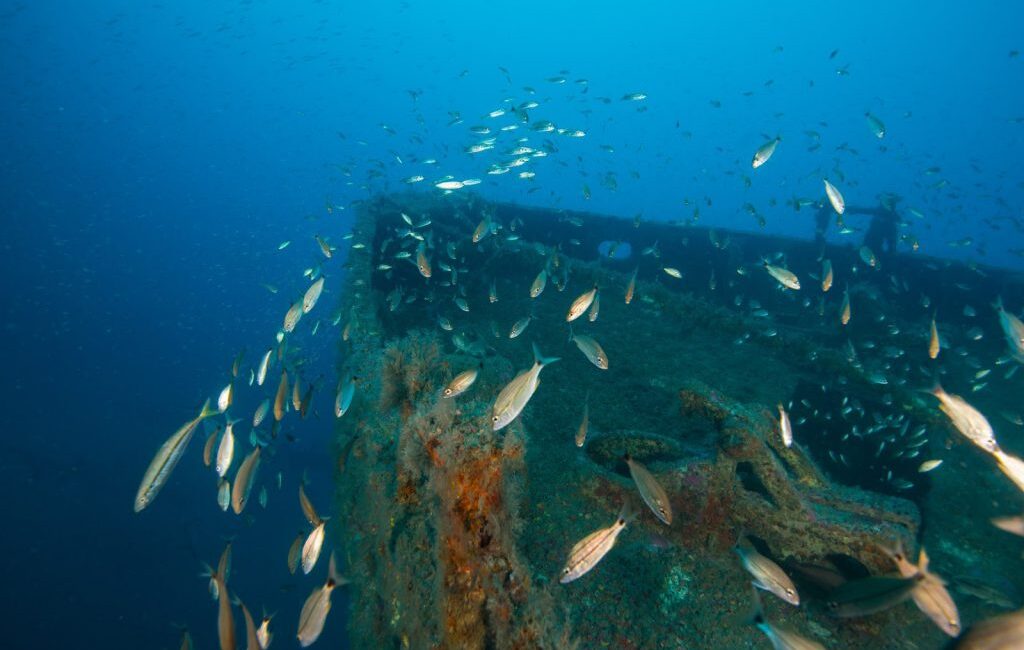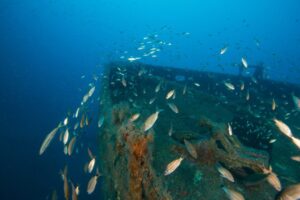
The Importance of North Carolina’s Artificial Reefs
Off the coast of North Carolina lies 43 ocean artificial reefs. Within the estuaries of our state are 25 artificial reefs,14 of which serve as oyster sanctuaries. Included in the artificial reef program are also sunken vessels. Some of which bring their own history to the Carolina coast.
Resting at the bottom of the Cape LookOut region (Artificial AR-302) is Yancey, a 5 star battle vessel that supported troops in WW11 and the Cuban Missile Crisis.
The North Carolina Division of Marine Fisheries maintains these reefs. The ocean reefs are located from less than a mile to 38 miles from the shore. The estuarine sites are found in Pamlico Sound and its tributaries, the New River, Bogue Sound, and Cape Fear River.
Why Do We Need Artificial Reefs?
Artificial reefs benefit our state economically, ecologically and scientifically.
- The reefs create habitat for fish and marine life. Healthy habitats increase fish populations which in turn create great fishing and diving sites.
- According to the American Sportfishing Association (2018) 2,263,900 anglers spent 1.4 Billion while fishing in North Carolina.
- The Carolina coast and estuarine waters have natural reefs however much of the seafloor is flat. Placing artificial materials on the sea floor provides new life to the area. Attracting marine organisms such as barnacles, soft corals, shellfish and seaweeds provides a food source for fish.
- The reefs with their overhangs, nooks and crannies also provide protection for fish. The smaller fish can find safe hiding from its larger predators.
- Artificial reefs are also considered crucial for spawning for many fish species that are popular with recreational and commercial fishermen.
- According to Marine Ecologist Avery Paxton the reefs also provide stepping stones for the fish as they grow.“When fish move from nearshore shallow waters when they’re younger to offshore deeper waters when they’re older, they use them as stepping stones to move along this corridor.”
What Kind of Artificial Reefs are There?
There are two types of manmade reefs in North Carolina that contribute to restoring and growing our habitat efforts, oyster sanctuaries and artificial reefs.
Oyster Sanctuaries:
Not only are oysters delicious to eat, they act as natural water purifiers by filtering and removing pollution from the ocean. A single oyster can filter up to 50 gallons of water a day. Oyster sanctuaries improve our ecosystem and promote growth of healthy oyster populations.
Cedar Island Oyster Sanctuary is a good example. A 75 acre project which started in 2021 and is scheduled to be completed in 2023. 18,000 tons of limestone marl have been deployed so far with another 18,000 tons to be added this year.

Artificial reefs:
Artificial reefs are built to provide a thriving habitat for fish and marine life. Just recently an artificial reef was deployed in the Pamlico River near the mouth of Bath Creek.
This was a joint effort between CCA NC (Coastal Conservation Association of North Carolina) and DMF (North Carolina Division of Marine Fisheries). Together they worked with local companies and Natrx, a global leader in the emerging field of nature-based adaptive infrastructure.
Natrx used a new type of 3D printing technology called “dry forming.” The end result simulates a more naturalistic structure with curved surfaces and textures that will allow marine life to thrive. Local fish species such as striped bass and speckled trout will benefit from these sand and cement reef cubes with their holes and crevices.
One hundred reef cubes, each measuring 3′ by 3′ and weighing approximately 1,850 pounds, were transported by barge and deployed at the Bayview Artificial Reef site (AR-291), located approximately 100 yards off the shoreline near the mouth of Bath Creek.
Where are the Artificial Reefs Located?
All kinds of vessels and aircraft – barges, fishing boats, and even planes have been stripped, cleaned and intentionally sunk in the Graveyard of the Atlantic to create reefs. One location off Atlantic Beach includes a 440-foot-long World War II Liberty Ship, a steel-hulled sport fishing boat, three F-4 jets and a CH-46 helicopter.
According to Sea Grant NC Coastwatch, environmental issues and tighter budgets has caused North Carolina to become more selective on where artificial reefs are located. With a focus on growing a healthier fish population the focus is more on new fishery habitats in estuarine areas where fresh water from rivers and streams mixes with seawater. Reefs in the estuarine area create habitats for young fish.
This is great on two fronts, more nursery areas for younger fish and more accessible reefs inshore. These reefs will also benefit those who don’t have access to a large offshore boat or prefer the calmer waters inshore vs the challenges of ocean fishing.
More Reef Locations
You no longer have to be a diver or boater to get a glimpse of one of the many artificial reefs or oyster sanctuaries. Thanks to the North Carolina Division of Marine Fisheries, anyone interested can explore them online through the interactive reef guide put together by the Division.
The reef guide provides the locations of the artificial reefs and the WRC boat ramps.
When on the site, click on the reef number icon and the following information is provided:
- Reef name
- General location
- Region
- Latitude and longitude
The site has layers so if you continue to zoom in, sonar scan details emerge. You can learn about the materials at the site such as reef balls, pilings, or if it’s a vessel that detail is shown. For example, if it’s a vessel you can click on the image and more details of the ship become available. Fascinating stuff.
North Carolina is known for great fishing both offshore in the Gulf Stream or inshore in our many creeks and rivers. If you enjoy fishing in-shore, the Inn On Bath Creek is an ideal place to stay. Just up the creek is the latest deployed reef. Our fishing is on the uptick.
0 Comments